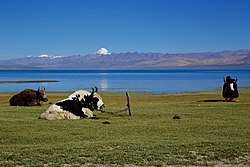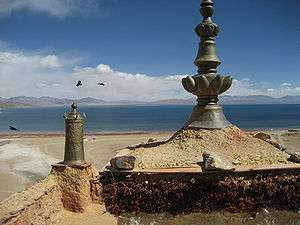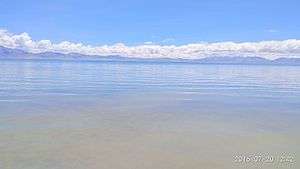Lake Manasarovar
| Manasarovar | |
|---|---|
 Lake Manasarovar with Mount Kailash in a distance. | |
| Location | Tibet Autonomous Region, Tibet |
| Coordinates | 30°39′N 81°27′E / 30.65°N 81.45°ECoordinates: 30°39′N 81°27′E / 30.65°N 81.45°E |
| Surface area | 410 km2 (160 sq mi) |
| Max. depth | 90 m (300 ft) |
| Surface elevation | 4,590 m (15,060 ft) |
| Frozen | Winter |
Lake Manasarovar (Tibetan: མ་ཕམ་གཡུ་མཚོ།, Wylie: ma pham g.yu mtsho ; Chinese: 玛旁雍錯 (simplified), 瑪旁雍錯(traditional) also called Mapam Yumtso, is a high altitude freshwater lake fed by the Kailash Glaciers[1] near Mount Kailash in the Tibet Autonomous Region of China. The lake is revered a sacred place in four religions: Hinduism, Bön, Buddhism and Jainism.
Etymology
The Sanskrit word "Manasarovar" (मानसरोवर) is a combination of two Sanskrit words; "Mánas" (मानस) meaning "mind (in its widest sense as applied to all the mental powers), intellect, intelligence, understanding, perception, sense, conscience"[2] while "sarovara" (सरोवर) means "a lake or large pond".[3]
Geography

Lake Manasarovar lies at 4,590 m (15,060 ft) above mean sea level, a relatively high elevation for a large freshwater lake on the mostly saline lake-studded Tibetan Plateau.
Lake Manasarovar is relatively round in shape with the circumference of 88 km (54.7 mi). Its depth reaches a maximum depth of 90 m (300 ft) and its surface area is 320 km2 (123.6 sq mi). It is connected to nearby Lake Rakshastal by the natural Ganga Chhu channel. Lake Manasarovar is near the source of the Sutlej, which is the easternmost large tributary of the Sindhu. Nearby are the sources of the Brahmaputra River, the Indus River, and the Ghaghara, an important tributary of the Ganges.
Lake Manasarovar overflows into Lake Rakshastal which is a salt-water endorheic lake. These lakes used to be part of the Sutlej basin and were separated due to tectonic activity.
Climate
| Climate data for Lake Manasarovar | |||||||||||||
|---|---|---|---|---|---|---|---|---|---|---|---|---|---|
| Month | Jan | Feb | Mar | Apr | May | Jun | Jul | Aug | Sep | Oct | Nov | Dec | Year |
| Average high °C (°F) | −3.2 (26.2) |
−2.0 (28.4) |
0.9 (33.6) |
6.4 (43.5) |
10.2 (50.4) |
13.7 (56.7) |
13.7 (56.7) |
13.1 (55.6) |
13.1 (55.6) |
11.1 (52) |
6.5 (43.7) |
1.0 (33.8) |
7 (44.7) |
| Daily mean °C (°F) | −8.9 (16) |
−7.6 (18.3) |
−4.2 (24.4) |
−0.1 (31.8) |
3.1 (37.6) |
7.1 (44.8) |
8.4 (47.1) |
8.0 (46.4) |
8.0 (46.4) |
5.4 (41.7) |
−0.2 (31.6) |
−5.1 (22.8) |
1.2 (34.1) |
| Average low °C (°F) | −14.5 (5.9) |
−13.1 (8.4) |
−9.2 (15.4) |
−6.6 (20.1) |
−4.0 (24.8) |
0.6 (33.1) |
3.1 (37.6) |
3.0 (37.4) |
−0.2 (31.6) |
−6.8 (19.8) |
−11.1 (12) |
−13.3 (8.1) |
−6 (21.2) |
| Average precipitation mm (inches) | 52 (2.05) |
34 (1.34) |
52 (2.05) |
30 (1.18) |
26 (1.02) |
40 (1.57) |
125 (4.92) |
135 (5.31) |
66 (2.6) |
29 (1.14) |
7 (0.28) |
18 (0.71) |
614 (24.17) |
| Source: Climate-Data.org | |||||||||||||
Religious significance



In Hinduism
According to Hinduism, the lake was first created in the mind of the Lord Brahma after which it manifested on Earth.[4] In Hinduism, Lake Manasarovar is a personification of purity, and one who drinks water from the lake will go to the abode of Shiva after death. He is believed to be cleansed of all his sins committed over even a hundred lifetimes.[5]
Like Mount Kailash, Lake Manasarovar is a place of pilgrimage, attracting religious people from India, Nepal, Tibet and neighboring countries. Bathing in Manasarovar and drinking its water is believed by Hindus to cleanse all sins.[6] Pilgrimage tours are organized regularly, especially from India, the most famous of which is the yearly "Kailash Manas Sarovar Yatra". Pilgrims come to take ceremonial baths in the waters of the lake.
Lake Manasarovar has long been viewed by the pilgrims as being nearby to the sources of four great rivers of Asia, namely the Brahmaputra, Ghaghara, Sindhu and Sutlej, thus it is an axial point which has been thronged to by pilgrims for thousands of years. The region was closed to pilgrims from the outside following the Battle of Chamdo; no foreigners were allowed between 1951 and 1980. After the 1980s it has again become a part of the Indian pilgrim trail.[5]
According to the Hinduism, the lake was first created in the mind of Brahma after which it manifested on Earth.[4] Hence it is called "Manasa sarovaram", which is a combination of the Sanskrit words for "mind" and "lake". The lake is also supposed to be the summer abode of the hamsa. Considered to be sacred, the hamsa is an important element in the symbology of the subcontinent, representing wisdom and beauty.[7]
According to Hindu theology, there are five sacred lakes; collectively called Panch-Sarovar; Mansarovar, Bindu Sarovar, Narayan Sarovar, Pampa Sarovar and Pushkar Sarovar.[8] They are also mentioned in Shrimad Bhagavata Purana.[9][10][8]
The People belong to this region is called Manasarovariya.Most of Them follow Hindu Religion are belong to Koli tribe called Manasarovariya Patel or Mandhata Patel claimed that their tribe belong to ancient King Mandhata of suryavansha of Ikshvaku dynasty and There is mountain named after his name called Gurla Mandhata is the highest peak of the Nalakankar Himal for glorify his achievement.
In the Bon religion
The Bon religion is also associated with the holy place of Zhang Zhung Meri sacred deity. When Tonpa Shenrab, the founder of the Bon religion, visited Tibet for the first time – from Tagzig Wolmo Lungring – he washed in the lake.
In Buddhism
Buddhists associate the lake with the legendary lake Anavatapta (Sanskrit; Pali Anotatta) where Maya is believed to have conceived Buddha. The lake has a few monasteries on its shores, the most notable of which is the ancient Chiu Monastery built on a steep hill, looking as if it has been carved right out of the rock.
The lake is very popular in Buddhist literature and associated with many teachings and stories. Buddha, it is reported, stayed and meditated near this lake on several occasions. Lake Manasarovar is also the subject of the meditative Tibetan tradition, "The Jewel of Tibet". A modern narration and description of the meditation was made popular by Robert Thurman.[11]
In Jainism
In Jainism, Lake Manasarovar is associated with the first Tirthankara, Rishabha. As per Jain scriptures, the first Tirthankar, Bhagwan Rushabhdev, had attained nirvana on the Ashtapad Mountain. The son of Bhagwan Rishabhdev, Chakravati Bharat, had built a palace adorned with gems on the Ashtapad Mountain located in the serene Himalayas.There are many stories related to Ashtapad Maha Tirth like Kumar and Sagar's sons, Tapas Kher Parna, Ravan and Mandodri Bhakti, among many others. [12]
See also
References
- ↑ Brockman, Norbert (2011). Encyclopedia of Sacred Places, Volume 1. ABC-CLIO. p. 356. Archived from the original on 2017-10-10.
- ↑ Williams, Monier. "Monier-Williams Sanskrit-English Dictionary". faculty.washington.edu. Archived from the original on 2012-12-03.
mánas n. mind (in its widest sense as applied to all the mental powers), intellect, intelligence, understanding, perception, sense, conscience, will RV. &c. &c. (in phil. the internal organ or antaḥ-karaṇa of perception and cognition, the faculty or instrument through which thoughts enter or by which objects of sense affect the soul IW. 53
• in this sense manas is always is always regarded as distinct from ātman and puruṣa, 'spirit or soul' and belonging only to the body, like which it is – except in the Nyāya – considered perishable - ↑ Williams, Monier. "Monier-Williams Sanskrit-English Dictionary". faculty.washington.edu. Archived from the original on 2015-05-20.
sarovara ○vara n. (accord. to some also m.) a lake or large pond, any piece of water deep enough for the lotus Kāv. Pur. &c
- 1 2 Charles Allen. (1999). The Search for Shangri-la: A Journey into Tibetan History, p. 10. Little, Brown and Company. Reprint: Abacus, London. 2000. ISBN 0-349-11142-1.
- 1 2 In Search of Myths & Heroes By Michael Wood
- ↑ Kailash Yatra. "About Holy Manasarovar Lake – Kailash Yatra". www.kailash-yatra.org. Archived from the original on 2016-05-02. Retrieved 2016-04-25.
- ↑ Eckard Schleberger, Die Indische Götterwelt. Eugen Diederich Verlag. 1997 (in German)
- 1 2 Encyclopaedia of tourism resources in India, Volume 2 By Manohar Sajnani
- ↑ "Narayan Sarovar Temple in Kutch ~ KACHCHH GUIDE". Kutchguide.blogspot.com. 2010-12-19. Archived from the original on 2015-07-23. Retrieved 2015-07-27.
- ↑ "Kutch Visiting Places and Tourist Attraction : Kutch Guide – Gujarat". Gujaratguideonline.com. Archived from the original on 2015-09-24. Retrieved 2015-07-27.
- ↑ The Jewel Tree of Tibet – Robert Thurman. Soundstrue.com. Retrieved on 2013-07-18.
- ↑ "'Lost' tirth of Jains traced to Himalayas - Latest News & Updates at Daily News & Analysis". dnaindia.com. 30 December 2011. Archived from the original on 15 August 2017. Retrieved 29 April 2018.
External links
| Wikimedia Commons has media related to Lake Manasarovar. |
| Wikivoyage has a travel guide for Mount_Kailash. |